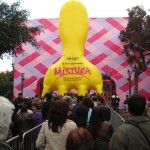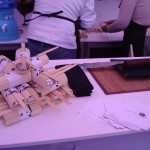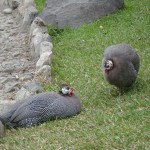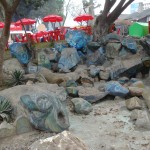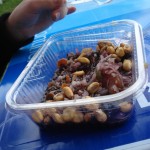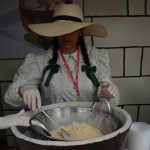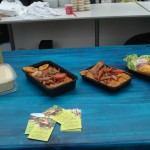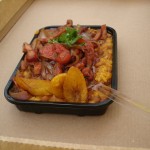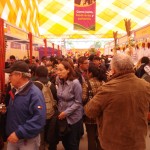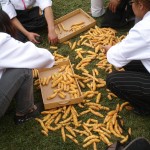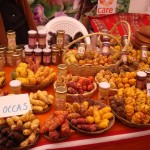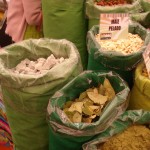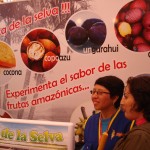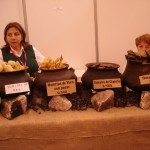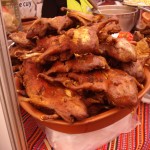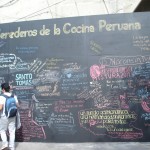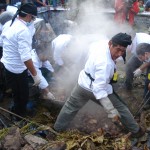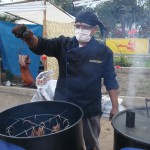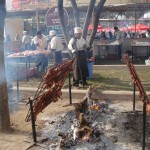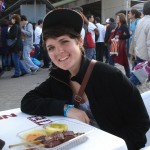“Lima: Gastronomic Capital of the World,” say the posters in town. Its a brag, of course, but it’s not without substance. The restaurant scene in Lima is kicking, full of cebicherías, chifas (chinese-peruvian fusion), parrilleras (grills), anticucherías (grills specialized in anticuchos. See photo) and I’ve been told it’s the home to a number of world-famous chefs. Lima is a cultural crossroads between Spain, the Andes, the Amazon, China, Africa, and more. What better place to have an entire festival devoted to food?
For ten days each September, the Parque de la Reserva in cental Lima is flooded with chefs, foodies, connoisseurs and tourists from around the world. Come hungry. Get reduced prices on delicacies from famous chefs, visit Huariques (hole-in the wall restaurants), indulge in Amazonian tacu tacu, then waltz over to the Sierra for some Pachamanca. Drink and purchase aromatic coffees that normally are for export only, get cheap and delicious pisco sour from el Rincón del Pisco.
How things work at Mistura: There are Banco Continental stands at various locations, where you can buy tickets of 1, 3, 6, and 12 soles. Then you take those tickets and buy food with them. It’s probably partly an effort to ease cashiering at food stands, and partly a way to encourage people to overestimate how much money they’ll need. Remember, you can always buy more tickets. Also, don’t make the mistake I did: I expected the tickets to be valid everywhere. With my wad of tickets in hand, I found that in the Gran Mercado, and at the really famous food stands, they often expect cash.
My favorite part was probably the Gran Mercado. Hundreds of stands of producers from all over the country, offering samples and selling cheese, fruits, kiwicha (a very nutritious andean grain) granola, every kind of potato imaginable, honey, wine, pisco, yogurt. It was interesting to see how things were marketed. Camu camu, an amazonian fruit, is supposed to be a rich in antioxidants (health fad?). I heard various Kiwicha astronaut references, confirming what our Anthropology professor, Juan Carlos, pointed out to us one day: that Kiwicha has become repopularized because astronauts eat it. Not because the Incas ate it, not because it’s Peruvian, local, and healthy. On the other hand, Peruvians eat rice with just about every lunch. Peru produces very little rice, instead importing it from Asia. Bread is a daily food, but Peru produces very little wheat, instead importing it from Argentina. As in the case of camu camu and kiwicha, there’s a certain market logic that can reconnect people with certain traditional foods, but it has to be presented as new and exciting.
Mistura isn’t just about stuffing your face, though. It’s great publicity for restaurants and food producers. It’s also an opportunity for people in the food industry to network. Vendors connect with producers, and they’re better able to find local, sustainable sources. For innovative companies that are trying to operate in environmentally responsible ways, conserving biodiversity in Peru, it’s a great way to share ideas and promote themselves.
My friend Emily and I had an interesting experience though: We were wandering in a seating area which was as packed as the rest of the park. Suddenly, a lady asks us in English “excuse me, are you tourists?” The easy answer was yes. She led us to a fenced area marked “Zona de turistas.” We walked through a supervised gate to a private seating area. If I remember correctly what they said, Mistura is working together with some tourism companies, and they have had the problem in the past that tourists have a hard time finding seating. So, because tourists are here for a limited time, which they expect to be enjoyable, there is a special seating area for their convenience.
We asked if all tourists were welcome, and they said that any tourist, foreign or Peruvian, could enter. We asked how they identified tourists, and they replied that they just have to guess.
As far as we could tell, everyone was having a hard time finding seating. Our lingering question was this: how did they know we were tourists? Before we even opened our mouths they spoke English to us and invited us over. They didn’t ask if we were with a tour company. It might have something to do with clothing, and perhaps to an extent you can tell by how people act, but it was probably mostly a race thing. We’re not special, but we’re white, so we look like tourists and get preferential treatment. So, among people who don’t look white, how do they distinguish tourists? A well-intentioned effort to aid the tourism industry seems to translate into a situation where white people have seats, and “other”s might not. It’s not a big deal in and of itself, but it’s not an isolated event. White students in Peru will be reminded of their privilege.
Reading over this, it’s quite a mixed review of Mistura. I thoroughly enjoyed myself, and ate way too much. But for the sake of candor, I also offer my criticisms. In any case, Mistura is an amazing culinary panorama of Peru. A must see if you’re in Lima in September.
Peace,
Ian
- That yellow thing is a fork, believe it or not
- A small selection of Peruvian produce
- Fruits with names
- Chocolate Sushi
- Oddest birds I’ve ever seen, hanging out by the pond
- Peru has churros, but of our own style. Filled with manjar blanco (dulce de leche, creamy caramel stuff), usually.
- Rock art
- More rock art
- Also spelled Ceviche and Seviche. Fish or seafood cured in lime with salt. Sooo delicious. Here in Peru, it’s typically served with chopped red onion, choclo (corn) or canchita (toasted corn), cilantro, aji (local peppers), sometimes bell pepper, and the best part is the sweet potato. Balances out the tartness. It’s a must-try in coastal Peru
- We got the cebiche de conchita negra, a shellfish whose name I’m not sure of. Good, though not as good as some seviche mixto that we’ve had
- Queso helado. I’m not sure why the name literally means “iced cheese,” since it’s not really cheese. All-natural ice cream. It’s cool to see them spinning it in the big bowl of ice, using those handles
- Typical Amazonian foods. From left to right: A soup that I forgot to ask about, 2 sizes of Tacu Tacu con saltado de cecina (rice and bean stew, normalmente served with egg and fried plantain. In this case, in stead of egg it had a type of cured meat), empanada de yuca (yuca is a tuberous shrub that grows in the Amazon. I think of it as an über-potato, extra starchy).
- Ajíes. There are so many kinds of peppers in Peru. It’s pretty awesome
- Tacu tacu con saltado de cecina. A typical Amazonian dish consisting of a rice and bean stew, typically served with egg and fried plantain. In this case, it had a cured meat instead of the egg. Delicious
- El gran mercado
- Oca. Similar to the potato, grown in the mountains. Because the peoples of the Andes were living between so many different altitudes and microclimates, and needed diversity of crops to have food security in poor soil, they developed a lot of varieties of potatoes. Several thousand. And other plants like Oca too.
- Coca and clay. This clay, which I can’t remember the name of, is apparently edible if you dissolve it. Medicinal purposes
- I’d never even seen these fruits before
- Humitas are comparable to tamales. I haven’t had them in Peru, but in Chile they were wrapped in corn husks, as opposed to banana leaves, and the edible part was corn-based, with chunks of corn in there and no meat, either sweet or salty.
- Aguaymanto. This fruit is similar to tomatillos with the leaves around it. But the flavor is like a tomato…only more tart and more sweet. These ones came from Ancash. Delicious.
- Fried cuy
- Somebody from Wisconsin beat me there! Though there’s an army of mad town folks at la Católica…some 20
- Tourist zone: awkward
- Pachamanca. This is a really cool food that I didn’t feel like standing in line for. Cooked in a hole in the ground: subterranean meat, potatoes, veggies, awww yeah
- Chancho al Cilindro: Similar to trash can turkey
- Chancho al palo
- Quality anticuchos. Definitely worth a lengthy wait in line
